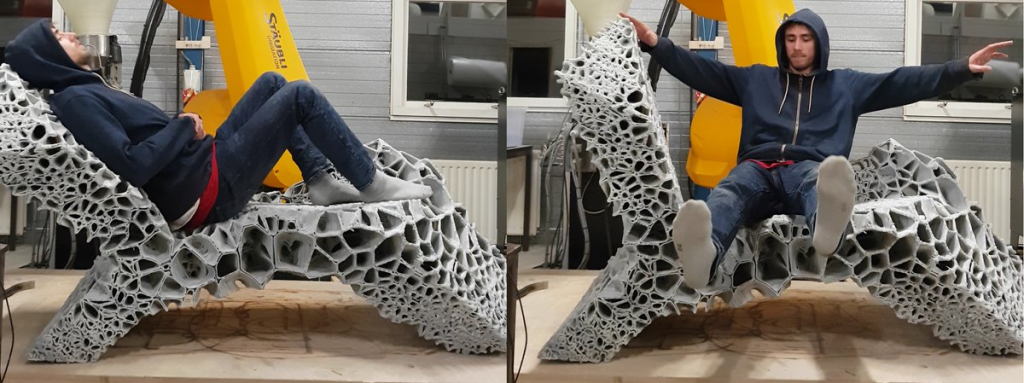 Netherlands-based Delft University of Technology (TU Delft) is one of the world’s leading higher learning institutions, evidenced by continual innovations in student research. We have followed as TU Delft faculty have 3D printed electronic devices, students have fabricated parts for racecars, and even performed studies regarding some pretty amazing potential for 3D printed bacteria and its uses in space; however, student research at TU Delft also seems to have a recent and strong focus on delving into the 4D, giving us a glimpse into the future as we move even beyond the third dimension and look forward to objects that can adapt and morph—depending on the needs of their users.
Netherlands-based Delft University of Technology (TU Delft) is one of the world’s leading higher learning institutions, evidenced by continual innovations in student research. We have followed as TU Delft faculty have 3D printed electronic devices, students have fabricated parts for racecars, and even performed studies regarding some pretty amazing potential for 3D printed bacteria and its uses in space; however, student research at TU Delft also seems to have a recent and strong focus on delving into the 4D, giving us a glimpse into the future as we move even beyond the third dimension and look forward to objects that can adapt and morph—depending on the needs of their users.
No strangers to the world of soft robotics, 3D printed shape-shifting assemblies, as well as the fabrication of a variety of metamaterials, researchers have now set their sights on 3D printed pieces that could change the way furniture is designed and manufactured in the future. Arwin Hidding is a student at TU Delft, centering around current work with the Robotic Building research group. After finishing his master’s degree in architecture (and just before embarking on his PhD in 3D printed architecture), Hidding began working on a design for an innovative chaise lounge that sounds as if it could spoil consumers forever in terms of features and comfort.
Transforming from a lounge chair into a bed within mere seconds, this 3D printed piece is all about giving the user what they require in the moment—whether they want to sit and relax—or lie down, activating movement as they lean against the rear of the chaise.
“In the past, furniture could only take on a different shape in cartoons. 3D robot printing, variable stiffness, and adaptive structures were unheard of at the time,” Hidding told 3DPrint.com.
“The aim of the project was to develop a 3D printable pattern that would allow control over the stiffness over the material. Variable stiffness is employed in this project as an adaptation strategy to achieve multi-functionality.”
Using growing expertise in the field of both 3D printing and architecture, Hidding and a team of TU Delft researchers experimented with the concept of shape-shifting furniture. Along with progressive design concepts, they relied on intricate structural analysis, robotic path simulations, and 3D Robot Printing BV for creating the ‘adaptive structure.’ The design is meant to support an average-sized human, with the morphing mechanism activated by their weight on the back of the structure.
“This shape change is achieved by combining variation in material distribution and use of thermoplastic elastomers,” Hidding told 3DPrint.com.
Henriette Bier reached out to us to explain the respective involvement of the team members saying,
“Variable Stiffness project is a 4TU funded project that I acquired with Patrick Teuffel, Qing Wang from TUE, and Senatore Gennaro from EPFL. After receiving the funding, I hired and supervised my former MSc student, Arwin Hidding (cc), during the whole process. TUE and EPFL were involved in regular reviews accompanying the process.
Furthermore, the project had partners from industry: 3D Robot Printing BV and 010 Works. In fact, the chaise longue was robotically 3D printed at 3D Robot Printing BV in Rotterdam with equipment that was developed by 3D Robot Printing BV.
Arwin is now guest researcher in the Robotic Building group, which I founded and lead since 2014. He aims to start a PhD supervised by me and funded by 3DRP and 010 Works.
The Variable Stiffness project builds up on expertise developed since 2014 in the Robotic Buidling group. In particular knowledge and technology developed in the project Scalable Porosity formed basis for design and robotic production approach.”
The 3D printed chaise lounge is slated to be on display for the public at the Dutch Design Week from 20-28 of October in Eindhoven. Find out more about this project and other Robotic Building projects here.
What do you think of this news? Let us know your thoughts! Join the discussion of this and other 3D printing topics at 3DPrintBoard.com.
Subscribe to Our Email Newsletter
Stay up-to-date on all the latest news from the 3D printing industry and receive information and offers from third party vendors.
Print Services
Upload your 3D Models and get them printed quickly and efficiently.
You May Also Like
Reinventing Reindustrialization: Why NAVWAR Project Manager Spencer Koroly Invented a Made-in-America 3D Printer
It has become virtually impossible to regularly follow additive manufacturing (AM) industry news and not stumble across the term “defense industrial base” (DIB), a concept encompassing all the many diverse...
Inside The Barnes Global Advisors’ Vision for a Stronger AM Ecosystem
As additive manufacturing (AM) continues to revolutionize the industrial landscape, Pittsburgh-based consultancy The Barnes Global Advisors (TBGA) is helping shape what that future looks like. As the largest independent AM...
Ruggedized: How USMC Innovation Officer Matt Pine Navigates 3D Printing in the Military
Disclaimer: Matt Pine’s views are not the views of the Department of Defense nor the U.S. Marine Corps Throughout this decade thus far, the military’s adoption of additive manufacturing (AM)...
U.S. Congress Calls Out 3D Printing in Proposal for Commercial Reserve Manufacturing Network
Last week, the U.S. House of Representatives’ Appropriations Committee moved the FY 2026 defense bill forward to the House floor. Included in the legislation is a $131 million proposal for...



































